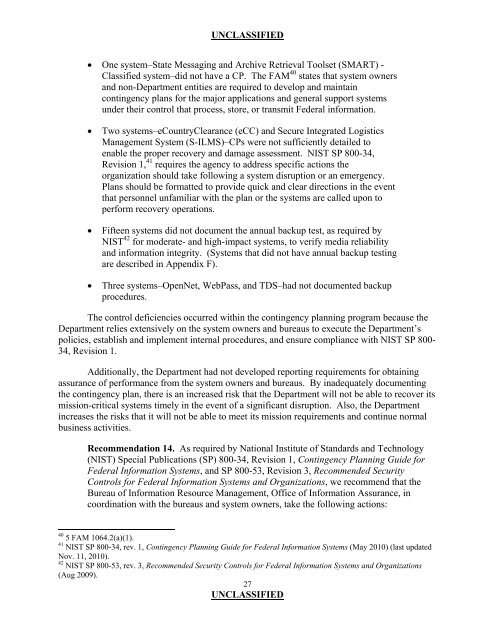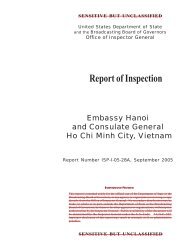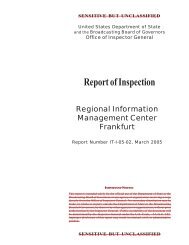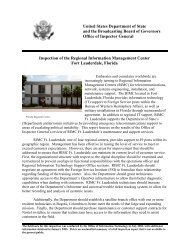Evaluation of Department of State Information Security Program ...
Evaluation of Department of State Information Security Program ...
Evaluation of Department of State Information Security Program ...
Create successful ePaper yourself
Turn your PDF publications into a flip-book with our unique Google optimized e-Paper software.
UNCLASSIFIED<br />
� One system–<strong>State</strong> Messaging and Archive Retrieval Toolset (SMART) -<br />
Classified system–did not have a CP. The FAM 40 states that system owners<br />
and non-<strong>Department</strong> entities are required to develop and maintain<br />
contingency plans for the major applications and general support systems<br />
under their control that process, store, or transmit Federal information.<br />
� Two systems–eCountryClearance (eCC) and Secure Integrated Logistics<br />
Management System (S-ILMS)–CPs were not sufficiently detailed to<br />
enable the proper recovery and damage assessment. NIST SP 800-34,<br />
Revision 1, 41 requires the agency to address specific actions the<br />
organization should take following a system disruption or an emergency.<br />
Plans should be formatted to provide quick and clear directions in the event<br />
that personnel unfamiliar with the plan or the systems are called upon to<br />
perform recovery operations.<br />
� Fifteen systems did not document the annual backup test, as required by<br />
NIST 42 for moderate- and high-impact systems, to verify media reliability<br />
and information integrity. (Systems that did not have annual backup testing<br />
are described in Appendix F).<br />
� Three systems–OpenNet, WebPass, and TDS–had not documented backup<br />
procedures.<br />
The control deficiencies occurred within the contingency planning program because the<br />
<strong>Department</strong> relies extensively on the system owners and bureaus to execute the <strong>Department</strong>’s<br />
policies, establish and implement internal procedures, and ensure compliance with NIST SP 800-<br />
34, Revision 1.<br />
Additionally, the <strong>Department</strong> had not developed reporting requirements for obtaining<br />
assurance <strong>of</strong> performance from the system owners and bureaus. By inadequately documenting<br />
the contingency plan, there is an increased risk that the <strong>Department</strong> will not be able to recover its<br />
mission-critical systems timely in the event <strong>of</strong> a significant disruption. Also, the <strong>Department</strong><br />
increases the risks that it will not be able to meet its mission requirements and continue normal<br />
business activities.<br />
Recommendation 14. As required by National Institute <strong>of</strong> Standards and Technology<br />
(NIST) Special Publications (SP) 800-34, Revision 1, Contingency Planning Guide for<br />
Federal <strong>Information</strong> Systems, and SP 800-53, Revision 3, Recommended <strong>Security</strong><br />
Controls for Federal <strong>Information</strong> Systems and Organizations, we recommend that the<br />
Bureau <strong>of</strong> <strong>Information</strong> Resource Management, Office <strong>of</strong> <strong>Information</strong> Assurance, in<br />
coordination with the bureaus and system owners, take the following actions:<br />
40<br />
5 FAM 1064.2(a)(1).<br />
41<br />
NIST SP 800-34, rev. 1, Contingency Planning Guide for Federal <strong>Information</strong> Systems (May 2010) (last updated<br />
Nov. 11, 2010).<br />
42<br />
NIST SP 800-53, rev. 3, Recommended <strong>Security</strong> Controls for Federal <strong>Information</strong> Systems and Organizations<br />
(Aug 2009).<br />
27<br />
UNCLASSIFIED








